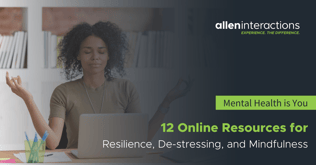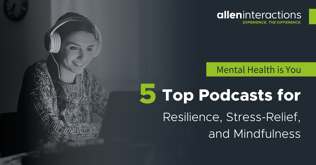Blog
Mental Health is You - 12 Online Resources for Resilience, De-stressing, ...
The Post-Traumatic Growth: Organizational Transformations series explores the concepts of Mass Scale Crisis, Organizational Trauma, Resilience, ...


Post-Traumatic Growth: We Answer Your Questions
By Dr. Christina Barss | January 06, 2021 | Strategic Consulting | 0 Comments
The Post-Traumatic Growth: Organizational Transformations series explores the concepts of Mass Scale Crisis, Organizational Trauma, Resilience, Trauma Informed Communication, and Post-Traumatic Growth. We also explore individual life-long resilience journeys from preschool to post-graduate to career skills in three interactive webinars with our experts, Dr. Christina Coidakis-Barss and Steve Larsen.
How is Organizational Trauma related to Stress Management?
Trauma is a specific type of stress. For example, in a stressful situation there is a perception of controlling the outcome, while in a traumatic situation, the perception of not controlling the outcome is driven by its unexpected and inescapable nature.
Organizational Trauma is a specific type of stress that reflects exposure to terrible events generally outside of the range of daily human experience that are emotionally painful, intense, and distressing. Traumatic events can result in particularly problematic trauma responses that are unique from general stress responses. Stress management helps us better respond to stress instead of reacting to it.
Traumatic experiences are always stressful, but stressors are not always traumatic. Likewise, stress is not always harmful while trauma nearly always is. The key take-a-way is learning how to identify organizational trauma, understanding that resilience and stress management can provide some relief but are not a panacea for organizational trauma and transformation. Organizational Post Traumatic Growth requires careful intervention.
Anxiety is a big challenge to overcome during stressful times. What do you recommend that would lead to Organizational Post-Traumatic Growth (PTG)?
Organizational trauma is caused by the work forces’ reaction to the event, not the event itself. Anxiety is a big challenge to overcome during these stressful times. The full impact of this pandemic will be deep and long, including the physical, emotional, social, civil, and economic repercussions. At an organizational level, it is important to help develop new routines as we navigate our ‘newest normal’.
Mitigating workforce anxiety is possible through human-centered compassionate, and consistent leadership. Acknowledge these difficult emotions, exist at different levels throughout your organization. Remember just as healing personally from trauma is a process, healing from organizational trauma is a process.
Researchers Pat Vivian and Shana Hormann recommend the following intervention actions to avoid long term traumatization:
- Create a sense of stability within an unstable environment. Addressing organizational emotion and anxiety is a continuous process. This fosters a feeling of safety which helps with emotional containment.
- Assign a name to the trauma, this will help focus and normalize the event. It becomes a point in your organizational history, with a before and after.
- Integrate the trauma in affirming and meaningful ways. Normalization of feelings and behaviors helps your team navigate the rocky seas of emotion. Open discussion about what happened increases psychological safety within the teams and organizations.
- Once the anxiety and stress has been addressed and your team is ready, lead them forward by shifting collective energy to a more action orientated framework. The last step is may be difficult to accomplish without an objective outside facilitator.
To be resilient as a leader, how do you process/ acknowledge feelings through chaos?
As a leader, first allow yourself to express and experience negative emotions. The American culture tends to “power through” or “push back” against negative emotions. Unfortunately, when strong emotions like grief, anger, sadness, or anxiety are denied full experience, they tend to increase their intensity. Unchecked, these denied emotions can become caustic and create problematic stress inducing illnesses and behaviors. Giving yourself permission to fully experience the emotion, allows you to regain strength by working through the emotion.
Creating a strategy for prevention, encouraging self-awareness of pre-tipping point warning signals and then the ability to de-brief openly in a team works best. Acknowledge different processing patterns and needs. Below is a quick exercise that can be done in the moment; turn off the Zoom camera, close your office door, sit in your car or even in the bathroom stall.
Thermometer Exercise – moving yourself from heated angst to cool calm:
- Raise your hand as the emotion rises
- Allow yourself to feel it, do not push it away
- Focus on your breath to keep you present
- Allow yourself to experience the emotion – call it out, name it
- As the emotion loses its intensity, lower your hand
- Breath normally as you return to calm
During organizational upheaval, as a leader, how do you make space safely for your team as well as your own feelings?
The current mass scale crisis we are experiencing is brand new to all leaders at all levels. Feeling overwhelmed as a leader is natural and understandable. Navigating overlapping crises within our organizations, many of us are experiencing increasing levels of tension, stress, and responsibility. Where do we find the strength to be supportive of others? How may we hold productive, and meaningful conversations that are authentic?
First, finding stability through grounding aids in making space for ourselves. Here are four ways:
- Remain realistic regarding the challenges you and your team are facing. This is a time of historical proportions. Pace yourself.
- Activate your network. Leading in a crisis can be lonely. Set up a Zoom call for 30 minutes with fellow leaders to share successes and challenges. You are not alone in this.
- Seek respite. Find ways to stay connected with family and practice selfcare. Model the behavior you will be asking of your team.
- Be prepared for your touch base meeting with your team. Be comfortable with silence. Have a one or two item agenda for these touch base meetings. Maintain focus on the human aspect – check in on their welfare like you would like others to check in on you.
Making space for others requires creating order out of chaos. Successful leaders build a framework of stability and consistency. This can be easily done through organizational habits like daily huddles and communication boards, stable communication devices that employees can rely on occurring regularly. Keep your huddles organized and candid. Acknowledge uneasy emotions and become comfortable with silence. Be open and honest with your team by establishing boundaries for information sharing. If there is a question asked you do not have an answer, let them know that and promise to find an answer by next huddle.
Do you think stress management/ emotional sessions/ training should be a part of new hire training/ onboarding?
Yes, we do!
In an ideal world, new hire training/onboarding would contain resilience and wellness training. Teaching self-awareness and regulation helps with stress management and resilience building. For successful behavior change, it would be part of a larger cultural and organizational initiative. When organizations value compassion and empathy. As they may have a higher level of resilience, they are also particularly susceptible to organizational trauma, secondary trauma, and vicarious trauma.
To be clear, training alone will not be enough to insulate an organization from stress, trauma and foster a psychologically safe environment. A multiple layer cultural initiative may include:
- Leadership: Training formal and informal leaders (coaches, mentors) to identify stress and trauma signs. Teach them how to hold safe space for others, individuals, and teams.
- Systems: Standardize mindfulness practices into important daily business agendas. Align mindfulness with your organizational mission and values to reinforce employee connection and engagement.
- Structure: Dedicated physical spaces such as oasis rooms or safe rooms for employees to recoup, regain composure and reset. These non-judgmental spaces normalize stress management and limit the contagion effect.
How do you help kids learn to be present and resilient?
Being present, resilient, and mindful are big concepts for young kids to understand. In simple terms, all three are about awareness; awareness of ourselves and our surroundings. A mindfulness practice helps kids deal with tough emotions. Resilience practices may even improve impulse control by teaching how to replace impulsive reactions with thoughtful responses.
Here are four suggestions to hold safe space for your kids:
- Role model the behavior you seek to teach your kids. Help them understand by demonstrating the quiet calm behavior and practices you expect of your child.
- Seek out professional, well-credentialed programs or books to help with developing skills. The internet is filled with many resources and ideas. One activity we find enjoyable: mindfulness card decks. For example, Imagine Meditation Cards for Kids by Imagine Meditation, LLC are bright and colorful, with scripting and activities. They are a great tool for educators, parents, and therapists.
- Manage your expectations. Be aware of your kid’s emotional readiness, plan practices based on that instead of age. Meet them where they are and not force them into practices that have the potential to further cause anxiety or stress.
- Be mindful of mindfulness. Land and expand your practice. For example, your kids’ daily practice may be a short three-minute activity focused on breathing or physical activity (like mindful movement) to slow down and increase focus. Follow this with an open-ended nonjudgmental question “how do you feel now?” to help them build self-awareness and confidence.
Check out the Post-Traumatic Growth: Organizational Transformations Webinar Series!

About the Author: Dr. Christina Barss
Dr. Christina Barss is an experienced industry subject matter expert in improvement sciences and organizational culture change. Her unique blend of practical, academic, and art perspectives creates custom operational and employee engagement solutions that transform the bottom line. For example, her PhD in sustainable systems design focused on disparately located interprofessional teams in transition during lean transformation at a large, midwestern, urban, academic medical center. Dr. Barss' 12 years in healthcare were filled leading strategic enterprise-level initiatives to improve patient safety, quality, service, and innovation as well as teaching and coaching executives. From C-suite to frontline, she connects seamlessly and guides others in building trust bridges. Her continuous improvement science foundation began in the manufacturing industry. She presents nationally and internationally on design thinking, change management, organizational culture, corporate learning, executive education, and succession planning.
Comments
Would you like to leave a comment?
Related Blog Posts

By: Dr. Christina Barss | Sep, 2021
Category: Custom Learning, Strategic Consulting

Blog
Mental Health is You - 5 Top Podcasts for Resilience, Stress-Relief, and ...
The Post-Traumatic Growth: Organizational Transformations series explores the concepts of Mass Scale Crisis, Organizational Trauma, Resilience, ...
By: Dr. Christina Barss | Jun, 2021
Category: Custom Learning, Strategic Consulting

Blog
Mental Health is You: 5 Books to Build Resilience and Mindfulness
The Post-Traumatic Growth: Organizational Transformations series explores the concepts of Mass Scale Crisis, Organizational Trauma, Resilience, ...
By: Dr. Christina Barss | Aug, 2021
Category: Strategic Consulting, Change Management

